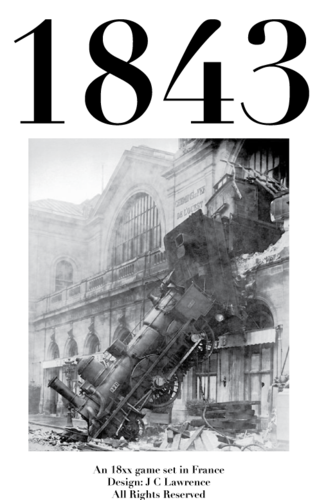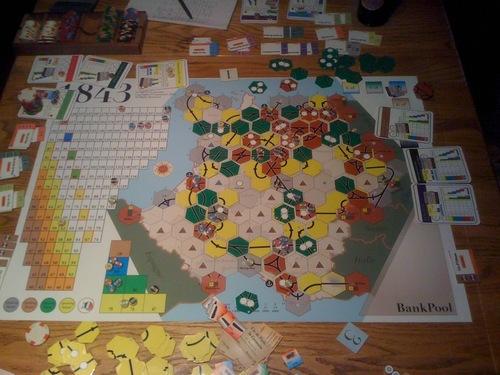A failure of noodles and limited touching
1839 has been lurching forward somewhat like a dyspeptic hedonist.
Privates
In May I attacked the privates:
- .
- Cost: $20
- Revenue: $5 (or $0?)
- Blocks: One side of Amsterdam.
- Power: Player can build an additional yellow track tile for $20 from their personal cash for any company of which they’re the president (any terrain costs must be paid by the company treasury), during that company’s operation and in addition to that company’s normal track build.
- Notes: Closed if sold to a public company or if power used. Power can be used in yellow phase.
- . 1
- Cost: $40
- Revenue: $5+
- Blocks: ?
- Power: Gets additional revenue of %20 of any terrain costs (rounded up) paid by any company. Terrain costs range from $80 - $120. Terrain tends to be where track wants to go.
- .
- Cost: $60
- Revenue: $5+
- Blocks: ?
- Power: Additional revenue of $5 for every train certificate bought by any company. When owned by a company, can mark a train as obsoleting rather than rusting ala the VdL in 1843.
- Note: Closes when its power is used.
- .
- Cost: $80
- Revenue: $5+
- Blocks: ?
- Power: 18OH-style revenue of $5 for every revenue location connected to a token for the first time.
- .
- Cost: $100
- Revenue: $20
- Blocks: The teleport locations
- Power: D&H style teleport for the cost of terrain at the target (one of which is $free but out of the way, other $120 and highly desirable).
- Note: Can be bought in yellow for face value. Closes as soon as its power is used.
- .
- Cost: $120
- Revenue: $20
- Blocks: Connectivity to Rotterdam
- Power: Either a 30% discount on a train purchase OR (exclusive) a token that can be placed under one of its station markers or on a dit. Every company that runs a train to/through that location pays half (rounded up) revenue of that location to the owning company’s treasury from the bank OR (exclusive, 3/4 player game only) may teleport/place a token in a space reserved/blocked by the discarded company for free.
- Note: Closes when the power is used. Revenue token is removed in brown phase.
- .
- Cost: $150
- Revenue: $25
- Blocks: Blocks Afsluitdijk.
- Power: Comes with a random %10 share (cf VdL/M&H). Owning company can place a station marker for free, or can place an additional/extra station marker (one more than normal for the company) for $100 (may be done out of order?).
- Note: Closes when the power is used. Afsluitdijk is built when private closes.
- .
- Cost: $220
- Revenue: $35
- Blocks: Flevoland bypass.
- Power: Comes with a random 20% presidency which is parred at $94 (cf PLM).
- Note: Closes when that company buys a train. May not be bought by a public company. Flevoland bypass is built when it closes.
These are auctioned in an 1830-style auction. Everything, including the trigger, will block something of importance. Purchase price by a major can be from $1 to 200%. The random share allocations, as well as which company is out of the game in a 3 or 4 player game, are determined during game setup before the auction. All privates close in brown.
After that is done one 10% share of each of the 8 off-board companies is auctioned in an 18Neb-style auction with a starting price of $60, with the extension that when all players pass all bid items are bought for their bids and everything remaining gets $5 cheaper. Repeat ad absurdum, must “buy” if $free. Note: The off-boards are parred at the highest then-legal par the first time a train is run to them. Until then their shares are not liquid. Off-board shares do not count as paper.
Summary: 16 things are auctioned before the ISR.
Priority is then sorted in order of ascending cash for the ISR (not sure about this?). At the end of all subsequent SRs priority sorts in order of descending cash (cf ‘43 and ‘44).
Trains
In June I went to work on the trains, which as-expected, changed everything. I should have known better than to touch anything else first.
First, all of a company’s train-routes must intersect, and at least one of them must end in an off-board. But additionally, each revenue location may be counted only once, no matter how many trains included it as part of their run (ala 1873)2. This of course will require all the station marker counts to be revisited.
Additionally presidents may buy up to 60% from the IPO but may buy past 60% from the Open Market. If they reach 80% their paper limit goes up by one each time. 80% of a company may be in the pool, but no more than 50% may be sold in a single sale. Share distribution is identical to 1849 with the second 20% share always being heavy.
But back to the trains:
| Colour | Type | Count | Cost | Rusted | Est. Run | Cost/Run |
|---|---|---|---|---|---|---|
| yellow | 2 | x5 | $125 | by blue | $40 | 0.32 |
| orange | 2+1x2 | x5 | $200 | by purple | $70 | 0.35 |
| green | 3/5x2 | x5 | $500 | by brown | $160 | 0.32 |
| lime | 4x2 | x5 | $600 | by red | $210 | 0.35 |
| blue | 4/6x2 | x5 | $700 | by red | $220 | 0.31 |
| purple | 5x2 | x5 | $800 | by gray | $270 | 0.34 |
| brown | 5Ex2 | x9 | $1,000 | by gray | $360 | 0.36 |
| red | 6ED | x9 | $1,200 | by black | $360 - $480 | 0.35? |
| gray | Double-D | x9 | $1,400 | $500? | 0.36? | |
| black | Flood | x9 | $1,600 | $750?? | 0.46?? |
In short the lower train ranks are split Poseidon-style with the last trains of the rank (eg orange after yellow) being over-sized and more expensive, but rusting one rank later than the first trains of the rank. Unlike Poseidon I’m thinking of not making the rust-later trains a choice: the half-new technology is the only thing available.
- Note: Green phase still does not start until the green trains, brown-phase with the brown and gray with the gray.
The definitions and prices of the upper trains are uncertain. I’m modestly happy up to red with maybe a $25 adjustment here and there on the prices. I suspect the big trains might get a bit more expensive(!).
- E trains are infinite length, best-N-stops.
- The current idea for the 6ED is either infinite length and double the best 6 stops, or infinite length and the best 6 stops with the company’s stations doubled (ie not quite as good).
- A Double-D would be a standard diesel that doubles everything (seems like a Bad Idea).
- A Flood would be every revenue location that the company could see from all of its stations assuming infinite trains of infinite length (ie an 1873 diesel).
Given the smallness of the map and the large number of tokens, a diesel-equivalent train seems a weak idea. Other notions are welcomed. I like the simplicity of running a Flood for the late game.
The estimated runs for the big trains are atrociously bad. They depend intimately on track development and I’ve a hard time predicting that far into the game. The lower estimates are fairly reasonable if a bit optimistic.
The train counts are likely also poor. The intent is that with trains running for a ~third of their purchase price and with no cheap single trains ala 1843, that trains will move quickly enough that the players are always under capital pressure.
It is also assumed that companies will run out of capital and that presidents will need to pay out of pocket for trains starting fairly early and likely 2-3 times per game for some companies. As trains are not cheap and revenues are not high until the end-game (when they can be huge) this is hoped to be interesting. In partial support of this I’m tempted to use 18India-style dividends of anything between $0 and $INCOME/10 with the stock price falling to the left if the total dividend is smaller than 50% of the stock price or rising if the total dividend is equal to or more than 50% of the stock price.
Game End
- Bankruptcy still ends the game.
- $500 stock-value still ends the game at the end of that OR (ala 1843).
- The game also ends at the end of two sets of ORs during which the smallest brown-or-larger train owned by any company did not change during both sets of ORs (ie didn’t rust).
The intent is that the brown trains might be permanent (not often, but might be), the red trains will usually be permanent, and the gray trains will always be permanent (if they come out).
Stations
The new trains are causing the station marker counts to be re-examined. If some train types explicitly reward stations, then the total number of stations per company should not be as disparate as they are now (currently between 2 and 4 inclusive). The temptation:
- All companies have 2-3 stations after their home-station.
- Stations are more expensive: eg $50, $75, $100 for a company with a weak home-station; or $100, $150, $200 for a central company with a strong home-station.
- There should probably be a private which has a power of offering its owning company either an additional station marker, or a discount on an unplaced station marker.

